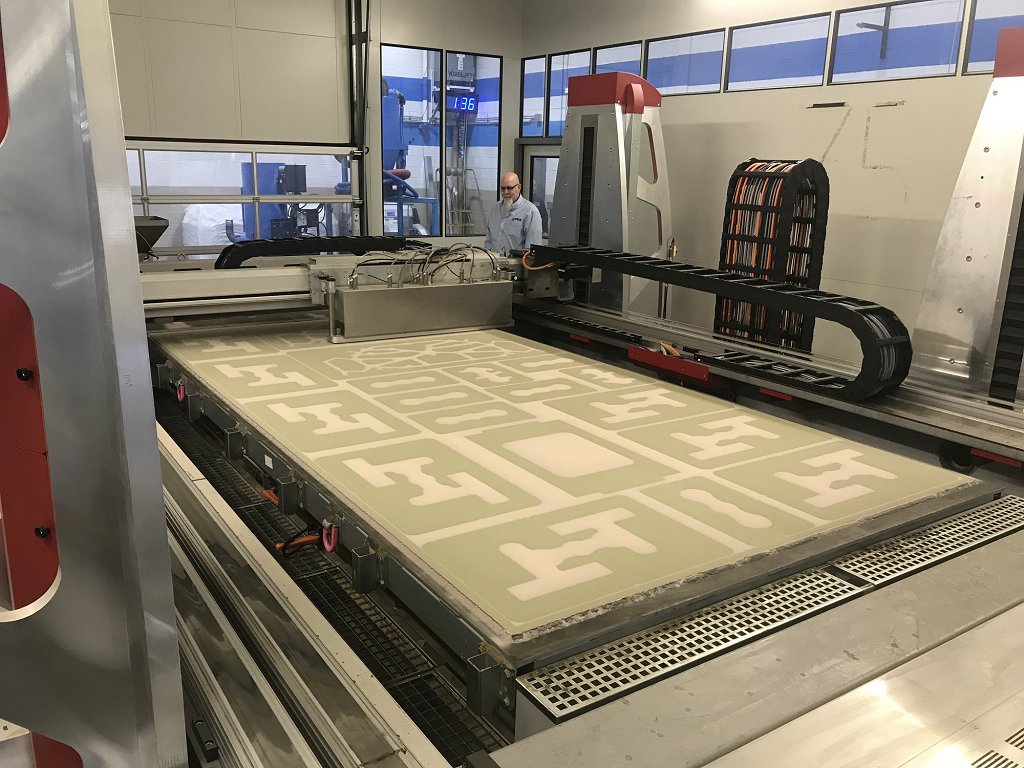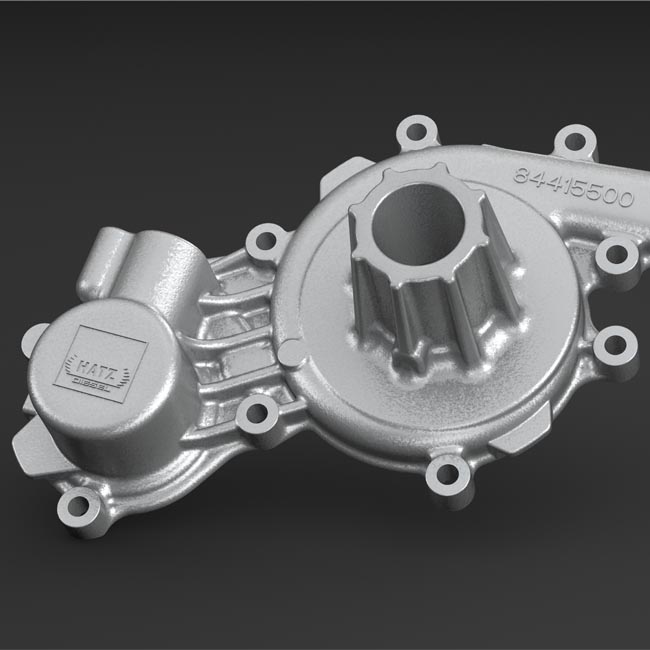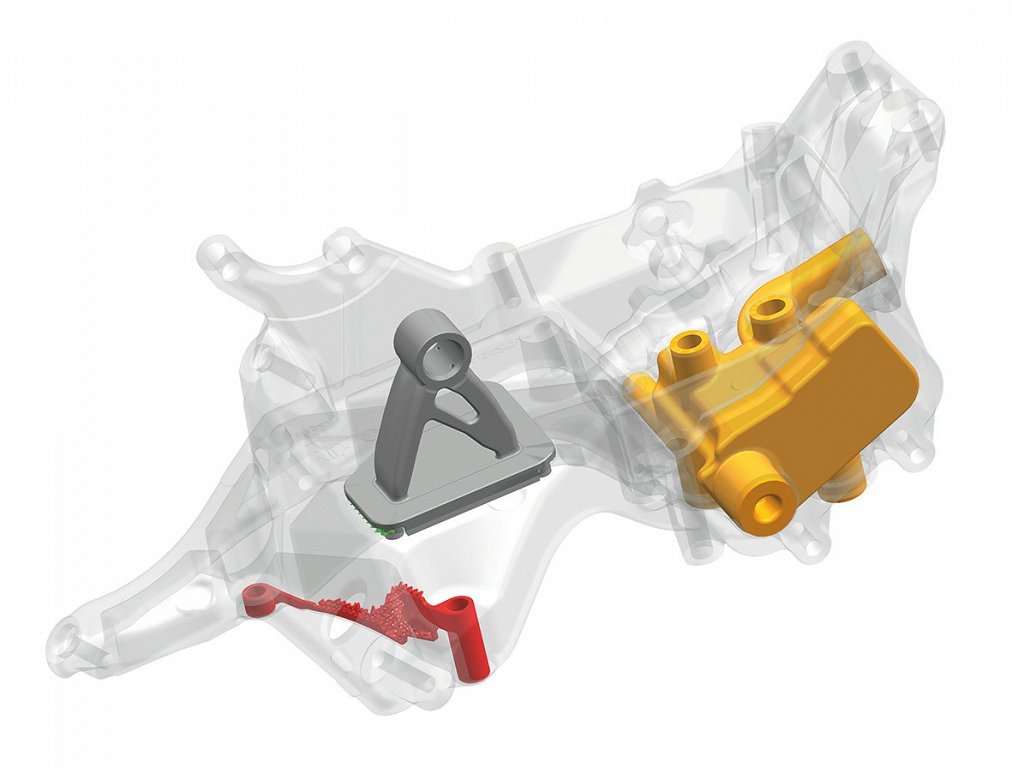Additive manufacturing and new production processes
12.04.2023
Additive manufacturing has undergone rapid growth in recent years and the future looks bright: experts expect further growth of around 20% within the next four years. The metal industries will also benefit from this. Steelworks and foundries, metallurgical plant manufacturers and suppliers are using 3D printing and new manufacturing processes for a wide variety of business models, as will be seen at the METEC, GIFA and NEWCAST trade fairs at the Bright World of Metals in Düsseldorf from 12 to 16 June 2023.
 Produced casting cores for the series production of large-format, weight-saving structural components for the Cadillac Celestiq: Voxeljet 3D sand printer VX4000 in use at the US automotive supplier Tooling & Equipment International (TEI). Image: TEI
Produced casting cores for the series production of large-format, weight-saving structural components for the Cadillac Celestiq: Voxeljet 3D sand printer VX4000 in use at the US automotive supplier Tooling & Equipment International (TEI). Image: TEI
Additive manufacturing with its varied choice of generative processes offers foundries and steel companies a wide range of opportunities. While for steel manufacturers direct metal 3D printing is primarily a complement to existing business and an increasingly important pillar in repair and spare parts procurement, indirect additive processes, in particular 3D printing of moulds, cores and models with sand, are stand-out options for foundries.
“Additive manufacturing has long been used for more than just prototyping,” says Dr Markus Heering, Managing Director of the VDMA’s Additive Manufacturing Working Group (AG AM) that was founded last year. In the mechanical engineering industry, additive manufacturing is a complementary manufacturing process that enables development and innovation, opening up new applications. The mechanical engineering expert explicitly underlines the potential of generative processes for the industry.
Steel companies and plant manufacturers: additional business with components and metal powders
Steel companies and plant manufacturers can benefit in many respects from additive manufacturing processes, as exhibitors and expert presentations at METEC as part of the Bright World of Metals from 12 to 16 June 2023 in Düsseldorf will illustrate.
The Düsseldorf-based SMS group is one of the few companies worldwide that covers the entire additive manufacturing process. As early as 2017, this metallurgical plant manufacturer and its partners began developing related processes on an industrial scale in order to make additive manufacturing competitive in series production, too. At the heart of their digitally controlled Additive Manufacturing Competence Center is a metal powder atomisation system developed by SMS boasting a capacity of 4,000 t per year, with connected powder grading and powder handling. The production system is completed by a large LPBF printer with a build envelope of 400 x 400 x 400 mm for additive manufacturing in metal, post-processing, quality control and shipping of the finished workpieces. A young research and development (R&D) team designs, manufactures and tests 3D-printed parts – mainly for the SMS group’s own products.
Prof. Dr. Hans Ferkel, Chief Technology Officer at SMS group, appreciates the benefits offered by additive manufacturing – being able to manufacture functionally optimised components with the greatest possible geometric freedom, which would not be feasible with classic manufacturing processes. SMS uses additive manufacturing to make series-produced plant components, for example. A first result was an award-winning spray head for forging presses, made of either plastic or metal. The lightweight and thus faster-moving component significantly shortens production time during forging, thereby increasing economic efficiency. The 3D-printed spray head consists of only one part instead of 16 and weighs just one tenth of a conventional spray head, which weighs around 80 kilos. It has flow-optimised channels and cools the dies in a targeted and individually adapted manner. At the same time, it is cheaper, more effective and can be manufactured individually as required. The 3D-printed spray head is already being successfully deployed by customers in the automotive industry.
As another successful example, the SMS head of research cites a flow-optimised design and additively manufactured hydraulic block for metallurgical plants. A conventional hydraulic block consists of a steel block with drilled channels through which the hydraulic oil used for power transmission must be forced. The straight channels drilled into the block inevitably always form butt connections. In terms of flow, the angular course is therefore unfavourable. A computer-calculated flow pattern is more like a digestive tract. Following nature’s example, the lowest possible pressure loss was realised on the path between the inlet and outlet. Newly calculated and additively manufactured, the hydraulic block achieves the optimum flow characteristics. Compared to its conventional predecessor, a much smaller compressor is sufficient to build up the required operating pressure in the hydraulic system, achieving significant energy savings.
Steel companies
More and more steel companies are using the full range offered by additive manufacturing. At Austria’s Voestalpine, the business extends from alloy development and metal powder production to design, manufacturing and finishing. With additive manufacturing, the group’s metal forming division offers its customers a supplement to its technology portfolio. Especially in the field of lightweight construction, this layered metallic deposition allows components with greater design freedom and increased functionality to be produced quickly and, ideally, cost-efficiently, as the technology group points out.
The world’s largest steel group ArcelorMittal has already been working since 2017 with Additive Industries, a manufacturer specialising in metal printing. Additive Industries sees itself as the world’s leading company for industrially integrated, scalable metal printers. Using 3D metal printing, ArcelorMittal produces ready-to-use spare parts on demand, including large steel spare parts for steelmaking or mining. “We started out printing small units and have now moved on to large and complex parts,” reports Jose López Fresno, Head of Additive Manufacturing at ArcelorMittal.
Foundry industry
Additive processes offer foundries a wide range of opportunities. Both direct metal printing as a complementary process to casting and, in particular, indirect processes such as printing of sand moulds, cores and patterns are possible here.
The FrankenGuss foundry, for instance, is active in the direct process. “Additive manufacturing is an excellent supplement to conventional casting processes,” reports the iron and aluminium foundry from Kitzingen in Main-Franconia. With the powder bed-based laser melting of metals, FrankenGuss also promotes small batch sizes and even one-offs. The spectrum of applications ranges from prototypes to lightweight components for aviation and e-mobility, or even highly stressable special components without a broad sales market, for instance for motor sports. Print-on-demand can also be used to produce individual spare parts, for example for the vintage car market. By scanning existing parts, these can be reproduced using reverse engineering, even if no design data is available.
Industrialisation of additive processes advancing
 Prototype of an additively manufactured water pump housing made of the aluminum alloy AlSi10Mg for a ride-on lawn mower.
Prototype of an additively manufactured water pump housing made of the aluminum alloy AlSi10Mg for a ride-on lawn mower.
Image: FrankenGuss
A current study carried out in collaboration with the Fraunhofer Institute for Casting, Composite and Processing Technology IGCV anticipates growth of around 20% in the field of additive manufacturing within the next four years. Additive processes have already successfully asserted themselves, especially for comparatively small quantities, for instance when complex geometry and a high degree of customisation are required. So far, this has mainly been the case in toolmaking, aerospace or medical products.
The industrialisation of additive processes is advancing and with the laser melting of metal, generative manufacturing processes are also gaining ground as fully-fledged manufacturing technologies. “We have reached the realm of series production,” confirms Dr.-Ing. Wolfram Volk, Professor at the Technical University of Munich and Managing Director at the Fraunhofer Institute for Casting, Composite and Processing Technology IGCV. However, a process such as selective laser melting (SLM) of metal is more economical for smaller components. Professor Volk points to the example of the automotive industry where additive manufacturing is already being used to produce quantities in the region of 1000 to 2000 components.
Promising 3D printing technology for foundries: sand-binder jetting
“Additive manufacturing can significantly change what a foundry offers,” says Professor Volk. In the foundry industry, the expert sees significant potential for 3D printing, especially in indirect processes such as the printing of sand moulds, cores and patterns using binder jetting. In sand-binder jetting, cores and moulds are built up layer by layer from sand that is held together with a hardening binder. The right binder plays a key role in this process. Producers of chemicals for the foundry industry such as Hüttenes-Albertus, Reinsicht or ASK have therefore developed special binder systems that are precisely tailored to the requirements of additively manufactured moulds and cores.
The actual casting process remains unchanged with sand-binder jetting. This seamless integration into conventional casting production processes represents a key advantage over direct additive manufacturing in metal, even in prototype construction. The properties of additively manufactured components are significantly different from those of cast components. Using laser melting of metal for prototype part production is therefore very limited. “The direct process can be used to produce a demonstration component, but this is usually also achieved using indirectly additively manufactured components,” Volk points out.
The degree of complexity and intricacy in binder jetting cannot be achieved with conventional casting methods. By eliminating the need for model construction, the use of a sand printer significantly shortens the manufacturing times of cast components. Sand moulds and cores or precision casting models can be produced in just a few hours. Depending on the degree of complexity, this can mean a time saving of several weeks.
At the Fraunhofer IGCV’s Foundry Technology Centre, Volk and his team collaborate with various plant manufacturers. Together with the experts at the IGCV, printer manufacturer Voxeljet has developed a sand printer in a project that can produce moulds for components weighing up to 80 t, for instance for wind turbines. “Scaling up the technology has been successful, but its economic viability has yet to be demonstrated,” Volk reports. The advantage of seamless over assembled moulds is offset by the disadvantage of the technological effort required to scale up the system.
An to printing a large mould is the modular, so-called voxel casting process,which is also being researched at the IGCV. Here, instead of printing a large mould, individual segments are printed and then reassembled like a 3D puzzle. “With voxel casting, we have very smooth surfaces that can be assembled using automation,” explains Volk, who sees great opportunity in the process. “Here, with the automated assembly of the core packages, casting and automated deburring with robots, we can achieve a very economalternativeical process that allows us to realise very large components.”
Rescued at sea: the example of sand printing
Just what today’s sand printing processes are capable of, can be seen in the example of Hetitec. This Finnish foundry is able to produce complex castings weighing up to 600 kg within a few days with the help of 3D printing of sand moulds and cores. By their own accounts, this makes them the fastest foundry in Finland. With this hybrid approach to printed casting, the geometric freedom of 3D printing can be combined with the cost benefit of conventional casting. Another advantage: compared to direct metal-processing additive technologies, metal casting has significantly greater material diversity. In addition to iron alloys, Hetitec can also cast various special steel and aluminium alloys.
The company likes to illustrate what speed means in practice using the example of a stranded icebreaker. The ship was lying off the Canadian coast with engine damage and the usual delivery time for the required spare part would have been five months. The shipping company turned to the Finnish foundry with a 2D design plan of the component, where the drawing was converted into a 3D CAD file within an hour. The following Monday, production began with the 3D printing of the sand moulds and by Friday of the same week, the machined, finished casting was on its way to Canada.
Hybrid manufacturing chains: combining additive manufacturing with casting
The sand-binder jetting process is not limited to printing moulds, cores and patterns. Foundry expert Volk also sees considerable potential in combining additive manufacturing and casting. “Hybrid production, i.e. casting additively manufactured components as inserts, makes sense in order to increase the degree of complexity. Here I see the greatest potential in the constructed sand casting processes.” Possible fields of application might include the automotive industry (e.g. battery trays) as well as robotics or medical device technology, he said.
The “casting-in” i.e. embedding of components has been tested for years. Successfully, for example, at Fraunhofer IFAM in Bremen, where the direct integration of electronic sensors and adaptronic functional elements in the die-casting process was developed with so-called Casttronics® technology. By combining die casting and additive manufacturing, IFAM was able to present an electric motor housing with an embedded “cast-in” cooling channel two years ago.
In another research project, the Fraunhofer Institutes IWS and IWU investigated hybrid manufacturing chains for automotive applications. Together with automotive supplier Edag Engineering and foundry Trimet Automotive (today Bohai Trimet), the “casting-in” or “casting-on” of additively produced metallic components was investigated. The aim of the CastAutoGen research project was to utilise the cost advantage (economies of scale) that arise during casting so as to achieve better economic efficiency with additive manufacturing, even for larger quantities. By casting in additively manufactured metallic components, for instance as heat exchangers or as reinforcements, the functionality of a component can be increased. Although this also pushes up manufacturing costs compared to a pure die-cast component, costs are significantly lower than for pure additive manufacturing.
One example of the added economic value generated by combining die casting and additive manufacturing methods was the casting in of a reinforcing core component made of a chrome-nickel-molybdenum alloy into an aluminium component. With the help of metallic inserts and reinforcements as well as laser deposition welding, an Audi front-end accessories bracket in die-cast aluminium was further developed into a variant-intensive, function-integrated product with the best possible performance.
 Heat exchanger (yellow) made of copper alloy, power steering pump bracket (blue) made of aluminum alloy and reinforcement insert made of stainless steel (red). Image: Edag Engineering
Heat exchanger (yellow) made of copper alloy, power steering pump bracket (blue) made of aluminum alloy and reinforcement insert made of stainless steel (red). Image: Edag Engineering
The result has potential – for instance for electric powertrains. The combination of additive manufacturing and die casting can also serve as a forward-looking manufacturing process for smaller-volume products such as high-performance vehicles that require new, highly function-integrated components.
Author: Gerd Krause, Mediakonzept Düsseldorf
Source: www.gifa.com




































